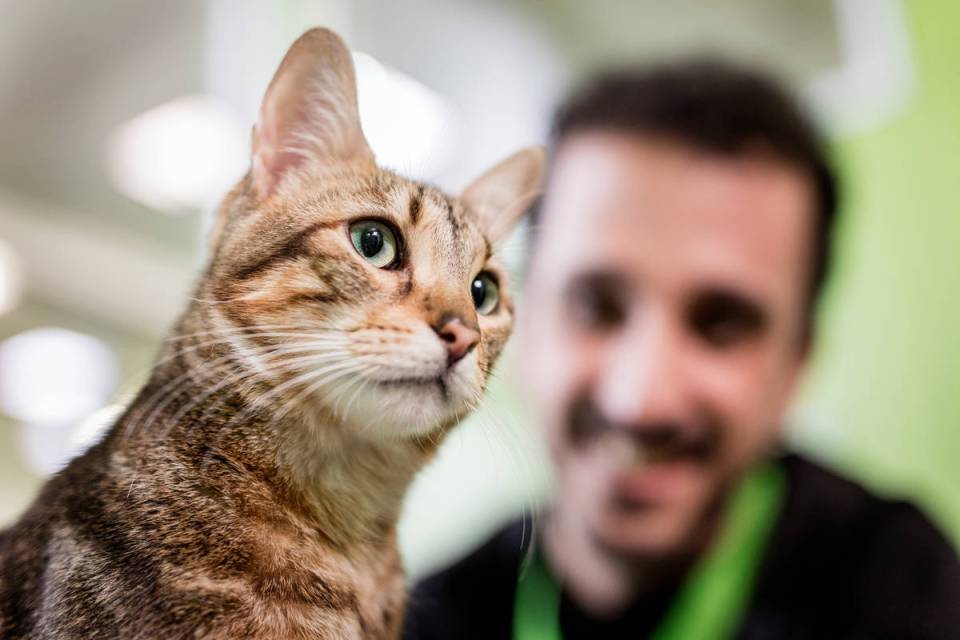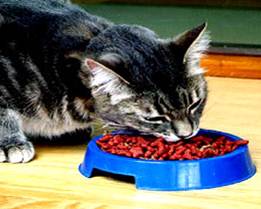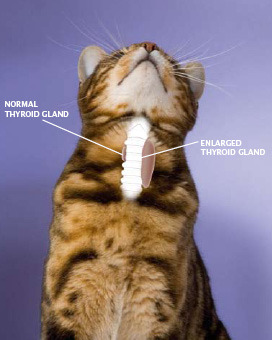
Hyperthyroidism
A page about hyperthyroidism in cats describing cause, clinical signs, diagnosis and control.
Introduction

The thyroid gland is divided into two lobes, one on either side of the windpipe in your cat’s neck. The thyroid gland produces thyroid hormone (thyroxine). In normal cats the gland cannot be felt.
The hormone produced by the thyroid gland is essential for the normal growth of the skeleton and brain in young animals.
It also has a wide variety of functions in adult animals:
- Involved in the control of metabolism
- Affects heart rate
- Helps control the breakdown of fatty tissues
- Involved in red blood cell production
What is hyperthyroidism?
Hyperthyroidism is when the thyroid gland makes and secretes very high levels of thyroid hormones.
Aetiology
This is caused by abnormal changes or tumors in the gland. These abnormalities are usually benign and can be treated successfully. A small percentage of cases (1-3%) are more complicated to treat and generally have a poorer long-term prognosis. The cause of the abnormal changes in the thyroid tissue is not known.
Epidemiology
- Hyperthyroidism was not recognised as a problem in cats until 1979. It is now considered a common disease of cats and the most common endocrinopathy.
- Both male and female cats are equally affected.
- It is thought that Siamese and Himalayan cats have a decreased risk of developing hyperthyroidism.
- It is most commonly diagnosed in older cats and a study of Irish cats (>7 years old) from the greater Dublin area found that >20% of cats that were enrolled in the study were affected.
Clinical Signs

Hyperthyroidism is a progressive disease with a slow, subtle onset, becoming more obvious with time. Early signs may be hard to recognise because the increased appetite and high levels of activity often seen are not always recognised as abnormal. The gradual deterioration in coat and body condition can also be wrongly attributed to the “normal signs” of aging.
Thyroid hormones control the speed of your cat’s metabolism, but when in excess, can cause a range of signs. The more thyroid hormone produced, the higher the metabolic rate and the more calories your cat burns.
Common signs include:
- an increased appetite and thirst
- weight loss – this may often be the most pronounced sign
- hyperactivity
- nervousness
- weakness
- breathing difficulties
- rapid heart rate
- a lump in the neck (goitre)
Not all of these signs will occur in every cat with hyperthyroidism.
Diagnosis

Your veterinary surgeon will diagnose that your cat is hyperthyroid from the history that you give, a thorough physical examination and laboratory tests.
a) Clinical Signs
The clinical findings are non-specific. Your cat may be at a very early stage of the disease. The physical findings may include
- an increased appetite and thirst
- weight loss – this may often be the most pronounced sign
- hyperactivity
- nervousness
Conditions such as kidney disease and heart problems are also common in older cats. It is important to check for concurrent diseases, this can influence the choice of treatment and prognosis for your cat.
b) Laboratory tests
There may be some haematological changes (erythrocytosis, neutrophilia or anaemia in advanced cases)
The following changes may be evident on serum biochemistry:
Mild to marked increases in liver enzyme activity
Mild to moderate increase in urea and creatinine
Thyroid hormone assay
The most reliable test for confirming hyperthyroidism is demonstration of an elevated serum total T4 (TT4) and/or free T4 (fT4) concentration.
Cats with concurrent diseases and those in the early stages of hyperthyroidism may have thyroid hormone levels within the reference range. Moreover, there are significant daily variations in TT4 concentrations meaning that levels in a single sample may be within the reference range even in a hyperthyroid cat. If hyperthyroidism is suspected based on clinical signs, TT4 should be retested in 1 week. If TT4 is still within the reference range, other diagnostic tests should be considered as follows.
Other Tests
Free T4 levels by equilibrium dialysis
Thyroid imaging – important in detecting ectopic thyroid tissue (not uncommon).
Scintigraphy – abnormal glands have increased uptake of iodine and can be clearly identified. A gamma camera is required.
Ultrasound – limited use.
Absence of TT4 suppression by exogenous T3 – after measurement of basal TT4, T3 is injected repeatedly over a 2-day period and TT4 levels measured again. In normal cats TT4 is suppressed by 30-50%, whereas little supression is seen in hyperthyroid cats.
Thyroid stimulation tests – in normal cats administration of thyroid stimulating hormone (TSH) or thyrotropin releasing hormone (TRH) increases TT4, but this response is blunted in hyperthyroid cats. TRH is more readily available and the test is more sensitive.
Control
Medical treatment is used for long term disease management as well as prior to surgical thyroidectomy or radioiodine therapy.
The mercaptoimidazoles, thiamazole (methimazole) or its prodrug carbimazole, are used. Methimazole interferes with the synthesis and production of thyroid hormones by inhibiting thyroid peroxidase-catalyzed reactions.
Haematology, biochemistry and TT4 should be monitored frequently especially during the initial stages of treatment.
A variety of products are available for treatment under prescription from your vet. For further information on the most appropriate product consult your local veterinary practitioner.

Further information for owners is available on www.cat-hyperthyroidism.co.uk
Further information for veterinary practitioners is available on www.vidalta.co.uk.
